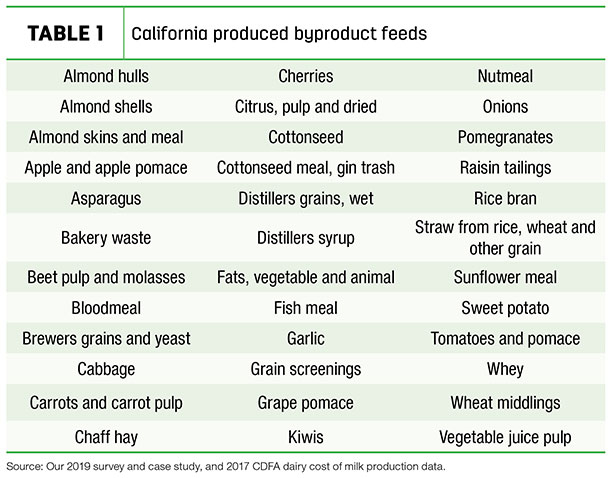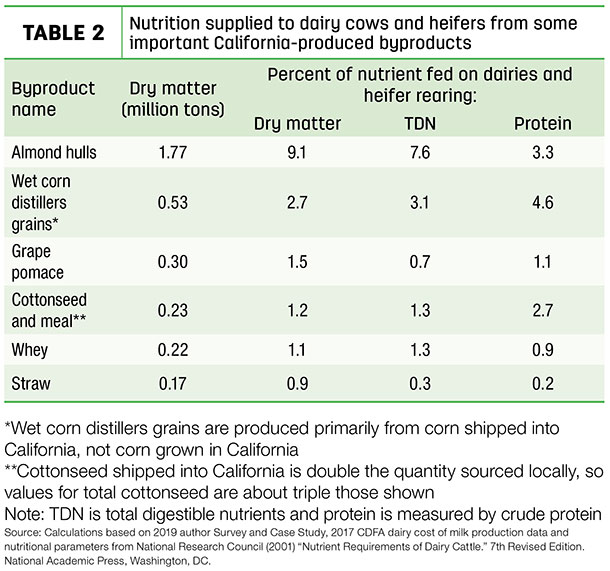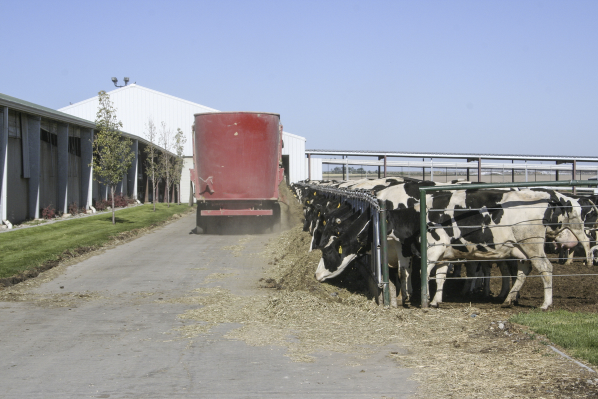Feed rations account for more than half of the cost of milk production; this number varies depending on the price of milk and feed. How dairies meet feed challenges determines, to a large extent, the economic, social and environmental sustainability of the dairy industry.
Harvesting and processing agricultural commodities and food manufacturing generate byproducts dairy farms use as feeds. This article summarizes the recent importance of byproducts as feed ingredients in the rations of dairy cows and heifers in California. We use the term “byproduct” to mean the residual material of plant or animal origin, produced during the harvest or manufacture of a primary product.
We show that feeding byproducts, including many locally produced byproducts, is a major feature of California dairy rations and is a significant part of processing and distribution for many California crops. Absent dairy byproduct feed, much more land and water resources would be needed to maintain the California herd, and more byproduct biomass would enter the waste stream with troublesome environmental consequences.
Byproduct feeds in the California dairy ration
Overall, we find more than 70 distinct byproduct feeds used on California dairy farms. Based on our 2019 survey of California dairies, 97% of milk cows in the San Joaquin Valley were on dairies that fed byproducts in their rations. Table 1 reports some of the California-produced byproducts reported in our 2019 survey of California dairies, a follow-up with 10 case study farms in the San Joaquin Valley and California Department of Food and Agriculture (CDFA) information from 2017.

Most individual byproducts and most tons of byproducts are California-produced. Among the notable byproducts shipped into California are canola meal, soybean meal and dry corn distillers grains.
The list in Table 1 gives a sense of the wide range of California-sourced byproducts. For example, rice and wheat straw derive from farm harvesting. Citrus pulp, tomato pomace and bakery waste derive from food manufacturing – and finally, some are cull fruits and vegetables, such as asparagus and kiwis. Not all byproducts are plant-based. For example, whey, a byproduct from cheese production, generally enters the human food market, but some is returned to dairies for use as feed.
Detailed calculations based on a broadly representative sample of rations from 2017 and early 2018 indicate that byproducts represent about 38.2% of ration dry matter and 40.6% of feed costs for rations of lactating and dry cows in California. These calculations use CDFA data on cost of production, including a detailed survey of cow rations from a representative sample of more than 100 dairy farms from across California. Our calculations allocate a share of composite feed listings, such as “mill mix,” into byproducts based on supplementary information gathered from CDFA personnel and industry participants.
Almond hulls, canola meal, cottonseed and distillers grains were the major byproduct feeds as measured by the share of dry matter in a ration. Canola meal accounts for 10% of feed costs, cottonseed about 9% and almond hulls about 3.6%. Distillers grains, dry and wet, account for another 5.2% of ration cost. More than 65 other byproducts together account for another 13% of feed costs. Scaling up to statewide totals, these CDFA data indicate that in California about 5.9 million tons (on a dry matter basis) of byproduct feeds were included in rations for lactating and dry cows in 2017.
Dairy feed is the highest-value use for most of the byproducts produced in the Central Valley, and lactating cow rations are the highest-value use among the dairy rations for many byproducts. Nonetheless, in recent years, given the expansion of almond production, a growing share of the almond hulls used on dairies have been fed to dry cows and heifers.
Dairy nutrition from byproducts
Table 2 shows the nutritional contribution of California-produced byproducts in dairy rations.

The six byproduct feed ingredients are used in lactating cow, dry cow and heifer rations. To determine quantities fed for the feeds in Table 2, we use the following methodology. We calculated the quantity of almond hulls based on tons of kernels produced and 95% of hulls going to dairies. Wet distillers grains tons are based on ethanol production from four distilleries in California and grape pomace from wine grape production in the Central Valley. In both cases, industry sources say all the byproduct quantity goes to dairies.
Cottonseed and meal are based on California production, knowing that about 30% of cottonseed is crushed for oil, resulting in cottonseed meal. For whey and straw, we use CDFA data and heifer rations published in academic literature to estimate use. We also calculated dry matter, total digestible nutrient (TDN) and protein intakes from CDFA data and academic literature; cow and heifer inventories in 2019 were from the USDA Cattle report; and nutritional content of the feed ingredients are textbook values from the National Research Council.
The role of dairy feeding of byproducts in California agriculture and food processing
The San Joaquin Valley is home to about 1.5 million dairy cows and large crop production, processing and food manufacturing industries. Low transport costs are especially important for moist, perishable byproducts. For many California-produced byproducts, limited alternative markets exist without further processing and transportation. Hence without the dairy cows, some of these byproducts might be destined for waste, including landfills.
Almonds represent the largest crop industry by acreage and value in the Central Valley and are a significant economic contributor. Roughly 95% of the 2.14 million tons of almond hulls produced are used as dairy feed. As the almond industry has expanded, the quantity of hulls fed has grown. In 2019, the price of almond kernels was about $4,860 per ton, and the price of hulls was $121 per ton. With 1.68 pounds of hulls produced for every pound of kernels, hulls generate about 4% of the almond industry revenue. However, hulls are an important source of revenue to the huller/sheller companies which market the almond byproducts.
After decades of decline, about 290,000 tons of cottonseed were produced in California in 2019. About 65% of cottonseed is sold whole from the cotton ginners to Californian dairy farms. Cottonseed is a high-protein, high-energy feed fed with no additional processing. About 30% of cottonseed is crushed for oil and meal, and the remaining portion, less than 5%, is used as planting seed. We expect all cottonseed meal produced in California is also sold to dairies. Cottonseed generates about 20% of cotton industry revenue and cotton lint the other 80%.
Grape pomace, the mixture of seeds, stems and skins produced after crushing for juice or wine, is an important byproduct feed. In 2019, 4.11 million tons of grapes were crushed in California (CDFA Grape Crush Report, 2020). Pomace accounts for about 25% of the fresh weight of grapes. For large San Joaquin Valley wineries, we estimate – based on industry interviews – that 90% to 95% of pomace is sold wet as dairy cattle feed. Dried grape pomace has a small national market as feed. Composting grape pomace is an option, whereas some pomace from smaller coastal wineries, which are far from most dairy cows, may be sent to landfills.
The value of California byproduct feed supply
Based on nutritional requirements and costs of byproducts and substitute feeds, we estimate that California dairy ration costs are 20% lower because byproducts are available. That means milk production per hundredweight is about 10% lower and California produces more milk because of byproduct availability. We estimate that byproducts replace alfalfa hay and corn grain in dairy rations, but not corn silage. We find that byproduct availability as dairy feed opens up 1 million acres of cropland and 4 million acre-feet of water that would otherwise be needed for alfalfa hay. In addition, byproducts replace about 4 million tons of corn grain that would otherwise be used in California.
While most California-produced byproducts are individually small, the availability of almond hulls allows milk production in California to be about 2% higher than would otherwise be the case.
Dairies benefit the environment by using byproducts
Most industries get little revenue from byproducts. This means demand from dairies has only small shares in the economic health of those industries. For example, revenue from sales of brewers spent grains is a negligible share of the revenue of the beer industry. However, even in these cases, dairies may have important local environmental consequences as breweries struggle to find alternative places to dispose of spent grains. If California brewery spent grains were left to decompose, they would generate about 29,000 metric tons of carbon dioxide equivalent, about equal to the emissions of 5,000 cars.
Final remarks
Use of byproduct feeds is a crucial component of the economic and environmental sustainability of the California dairy industry, as well as the agricultural industries where byproducts are sourced. Access to byproducts helps keep production costs lower and improves the economic viability of the industry. Byproduct use also reduces environmental and resource pressures on cropland and especially irrigation water in the San Joaquin Valley. Access to byproduct feeds reduce the demand for land and water devoted to silage and alfalfa hay. Finally, California dairies convert agricultural and manufacturing byproducts that would otherwise be destined for the waste stream into nutritious dairy products for human consumption.
Daniel Sumner is the Frank H. Buck Jr. Distinguished Professor, and Jarrett D. Hart is a postdoctoral researcher in the department of agricultural and resource economics at UC – Davis. James Fadel was a professor of animal science at UC – Davis where Ziyang Fu was an undergraduate researcher. Jennifer Heguy is the dairy farm adviser and county director, UC Cooperative Extension in Merced and Stanislaus counties.
References omitted but are available upon request by sending an email to the editor.







